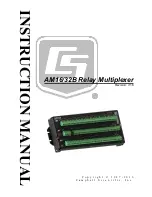
8
corrosion resistance, coat the terminals and connectors with
GB #OX-100 anti-oxidant compound (available at your local
hardware store). Replace and tighten the terminal connectors.
Secondly, if the terminals and connectors are making good
contact, touch the test leads to the battery and vehicle
framework as described above (see fig. 2). Note the reading
of the meter. Get an assistant to turn on the headlights while
the test leads are making contact. The needle indicator should
drop a few volts. Should the needle indicator drop 5 volts or
more, the battery should be charged or possibly replaced if
the voltage drop is significant. The circuit may need to be
checked further for problems within the electrical system that
may be draining the battery.
4.2 Alternators and Generators
Set the function/range switch to the 50V DC range. While the
engine is idling at normal operating speed, touch the black (-)
test lead to the metal framework of the vehicle, then touch
the red (+) test lead to the output terminal connector. The
alternator output cable is always the heaviest gauge cable
attached to the alternator (see fig. 3). The needle indicator
should read 12 volts or more. If the needle indicator moves
sporadically, the cable may need to be tightened. If the
engine is idling lower than is specified in the vehicle owners
manual, the voltage reading will be lower. If the output
voltage is significantly low, the alternator may require
service or replacement.
When making automotive measurements,
observe safety precautions. Stay away from the fan blades,
belts and other moving parts of the engine. Keep the
multimeter and its leads away from moving parts.
2) Set the function/range switch to the appropriate DC voltage
range. If the voltage is unknown, use the highest range. If
the voltage applied falls within the range of a lower setting,
reset the function/range switch to the appropriate setting for
greater accuracy.
3) If the polarity of the circuit to be tested is known, touch
the black test lead to the neutral side. If the polarity is
unknown, touch the test leads to opposite sides of the
circuit. If the needle indicator deflects to the left of the scale,
reverse the test leads.
Use the chart below as a guide to reading DC
voltage measurements:
DC V
Read
and
range
following
multiply
setting
scale
reading by:
10
0-10
1
50
0-50
1
250
0-250
1
500
0-50
10
Common DC Voltage Measurements
4.1 Automotive Batteries
Set the function/range switch to 50V DC. First check the
quality of the battery terminal connector by touching the
red (+) test lead to the connector while touching the black (-)
test lead to any bare metal framework of the vehicle. The
meter should read 12 volts or higher on the 0-50 scale with
all of the vehicle accessories turned off. If the needle indicator
moves sporadically, this indicates a bad terminal connection.
Remove the terminal connectors and clean both terminals
and connectors thoroughly. For improved conductivity and
7
Figure 2
Figure 3
!
WARNING






































